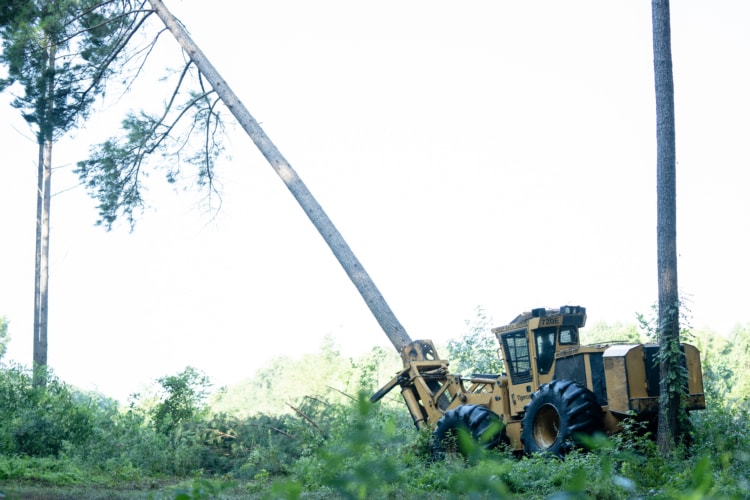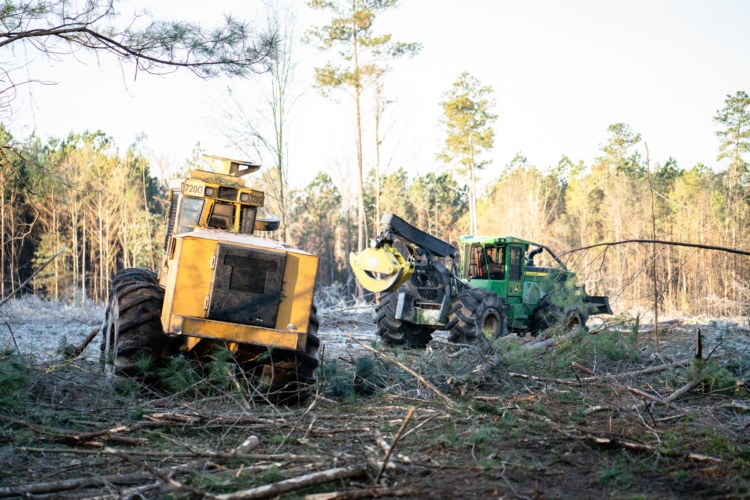As you can probably imagine, if tall, narrow tree stems (80′ or taller) begin swaying they can destabilize a wheeled machine that stands only 12 feet off the ground. Thankfully, this doesn’t happen often but when it does it can turn the whole machine right over. Unfortunately, this happened on one of our jobs last week.
A Bad Situation
On a hilly tract of very tall, beautiful pine in Lancaster County, SC our operator was running the fellerbuncher in uneven ground and had a long tree stem in its grasp. And then…the machine rolled over.
The operator was properly buckled so while scary the good news is he came away unharmed. The machine could have been fine too, but decisions made over the next few minutes meant it was not so lucky.
When a machine rolls all sorts of fluid and materials go in the opposite direction they should. Engine oil can get into the intake and then the oil can get on top of pistons which can lock up and destroy the whole engine, and debris can remain lodged inside becoming a fire hazard.
This is why we have an important Standard Operating Procedure for this. If a machine rolls over, the first thing you do after ensuring your own safety is to call your foreman and operations manager so they can help you and make contact with our dealer representative.
In a situation this serious, bringing these experienced people into the conversation right away makes sure that the exact right protocols are followed – which in this case is over 10 separate steps/tasks to return the machine to working condition (loggers: see the bottom for the whole SOP).
The Big Mistake
Neither the buncher operator (who was filling in that day) nor the skidder driver who came to the scene called their manager. And they did not follow the correct procedures. Instead, the skidder driver helped to roll the machine back over and the machine went back to work. For a very short time.
Because restarting the machine without following the SOP resulted in catastrophic failure of the engine and other systems. It will be a very, very expensive repair. In just a few short minutes, likely multiple months worth of the crew’s profit was lost. All because they didn’t make the right call and follow the procedure.
Careless vs. Thoughtless
My first reaction in a situation like this is probably what all of you are thinking…YOU’RE FIRED!!!
Ultimately, that may be the right decisions but it is important to collect yourself and think. The question I asked myself and tried to get to the bottom of was this: Was this employee acting careless, or was he acting thoughtless?
A careless employee simply doesn’t care. Doesn’t care the machine broke, doesn’t care it hurt the company, doesn’t care enough to learn from the experience and do it differently next time. Hopefully a careless employee is never hired, but if one is found…they are fired.
But on the other hand there is thoughtlessness. Did the situation happen fast and cause the employee to stop thinking? Now that its over is the employee full of regret and wants nothing more than a do-over? As painful as it might be, a thoughtless act when paired with an otherwise engaged employee can be a good teacher…after you make a big mistake your awareness is heightened and the chance you will make another can go down.
The Consequences for the Company
Keeping a careless employee is a cancer. But firing an otherwise good employee who acted thoughtlessly can be just as bad for the culture over the long term. The important part is knowing which you are dealing with and then broadcasting your reasoning and conclusion to the whole company.
I believe if you get the decision right, you can show that you stand by people who make mistakes, even large ones, and decrease the chance of big mistakes in the future. And at the end of the day, the future is all we still have the power to influence.
Procedure for Machine Rollover:
- Call your Foreman and Operations Manager. They will make contact with our dealer representative.
- Safely roll the machine back over – DO NOT TURN THE MACHINE BACK ON
- PROCEED FORWARD ONLY IF INSTRUCTED BY OPS/MANAGER OR DEALER
- Open all engine screens to fully clean out debris
- Remove piping from the turbo to inspect for oil
- Remove air filters to inspect for engine oil
- Remove air intake pipe from the engine and inspect for oil
- Remove oil from the CAC if any is found
- Use a 15/16 socket on a pull handle to turn the engine over at the alternator to ensure it will turn freely – do not spin the engine until this is done
- Check oil level and add new oil as needed
- Change the crankcase filters as they will be saturated and will cause premature turbo failure
- Get approval from Ops Manager or Dealer Rep to return machine to work




